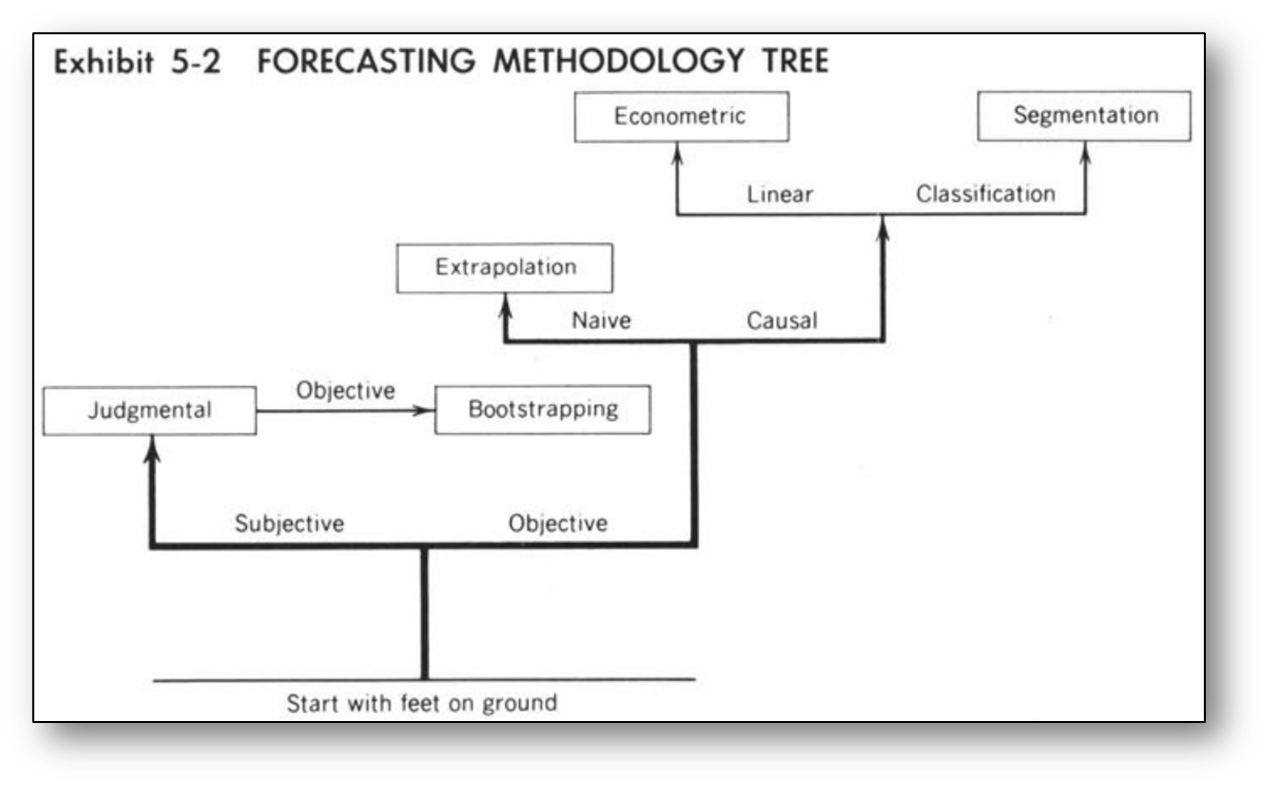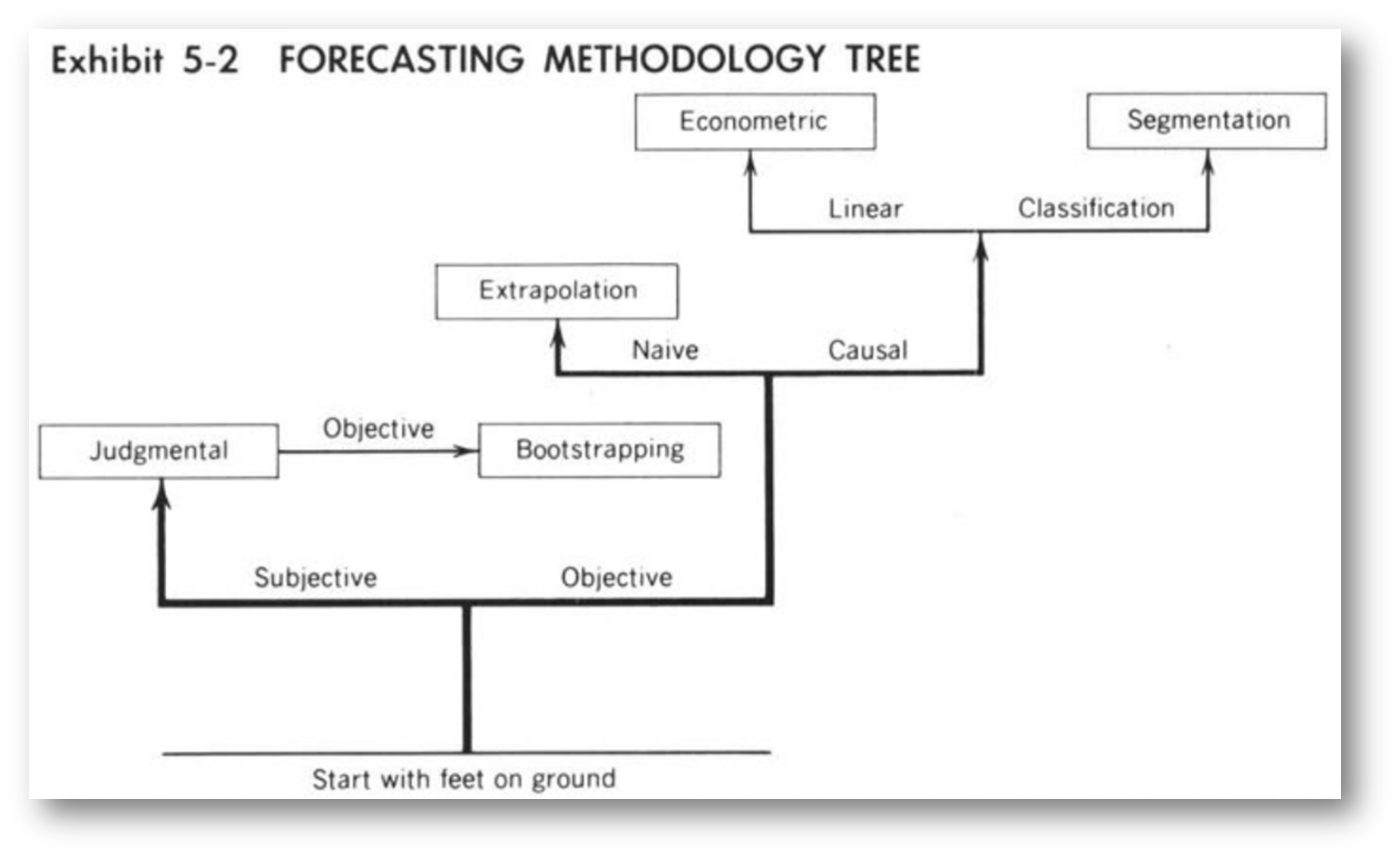Predictive Analytics - Introduction: Time series analysis
Question to answer
- Will a person buy a house? – Yes or no.
- How much will he pay for a house? – Amount of dollars.
- When will he buy a house? – A date.
- How long will he keep looking for a house? – Length of time period.
Types of Predictive analytics
- Objective methods:
- Causal models
- Time series
- Artificial Intelligence (AI)
- Subjective methods:
- Composites
- Surveys
- Jury of executive opinions
- The Delphi method
- Prediction or information markets
- Combined Methods

Subjective forecasting
Qualitative methods
Also called: implicit, informal, clinical, experienced-based, intuitive methods, guesstimates, WAGs (wild-assed guesses), or gut feelings.
Aggregation of expert opinions:
- Sales Force Composites – aggregation of sales personnel estimates
- Jury of executive opinions
- Surveys – customer surveys, political elections polls
The Delphi Method
- Interactive forecasting method which relies on a panel of experts
- The Delphi method is based on the assumption that group judgments are more valid than individual judgments
- Key characteristics:
- anonymity of participants;
- structuring of information flow;
- regular feedback;
- role of the facilitator.
Combined methods
- Increase a number of experts
- Take implicit subjective method and make it explicit and operational
- Right down rules used by experts to make their decisions and then use bootstrapping to create a huge number of opinions and converge to some decision
Objective forecasting
Based on abundance of data and objective (statistical) methods of data analysis
- Causal models: regression and classification models
- Time series analysis: trend, seasonality, moving averages, smoothing, …
- Artificial Intelligence (AI): Neural networks, Machine Learning, Deep Learning
Business questions:
What would be sales next month?
Will the client renew subscription?
Should the customer be given a home loan?
What is a probability of a customer to default?
What is weather forecast for tomorrow, next week, next season?
Causal models:
Time series analysis:
Artificial Intelligence (AI)

(ARMSTRONC, J. S. (1985). Long-Range Forecasting: From Cristal Ball to Computer (2nd Edn). New York: Wiley-Interscience. )
Time series
invisible(lapply(c("readr", "dplyr", "ggplot2", "tseries"), library, character.only = TRUE))
diet <- read_csv("Diet.csv")
diet <- diet %>% mutate(Date = as.Date(Week, format="%d-%m-%y"), Type="Real") %>% select(-Week)
ggplot(data=diet, aes(x=Date, y=Diet)) + geom_line(size=1)fit <- arima(diet$Diet[1:204], c(0, 1, 1), seasonal = list(order = c(0, 1, 1), period = 52))
pred <- predict(fit, n.ahead = 57)
diet2 <- rbind(diet, data.frame(Date=diet$Date[205:261], Diet=pred$pred, Type="Pred"))
ggplot(data=diet2, aes(x=Date, y=Diet, group=Type)) + geom_line(aes(color=Type), size=1) + theme(legend.position = c(0.1, 0.8))invisible(lapply(c("readr", "dplyr", "ggplot2"),
library, character.only = TRUE))
spx <- read_csv("SP 500 Historical Data.csv")
spx$Date <- as.Date(spx$Date, format="%b %d, %Y")
head(spx)
ggplot(data=spx, aes(x=Date, y=Price)) +
geom_line(size=1) +
scale_x_date(date_breaks = "1 year",
date_labels = "%Y")spx2 <- as.matrix(spx[, c("Open","High","Low","Price")])
rownames(spx2) <- as.character(spx$Date)
library(dygraphs)
dygraph(head(spx2, 50)) %>% dyCandlestick()
head(spx2)x <- data.frame(
Date=seq.Date(as.Date("2015/1/1"),
as.Date("2019/1/1"), by = "day")
)
x$Change <- rnorm(nrow(x), mean=0.0, sd=0.02)
x$Price <- cumprod(x$Change + 1) * 15
ggplot(data=x, aes(x=Date, y=Price)) +
geom_line(size=1) +
scale_x_date(date_breaks = "1 year", date_labels = "%Y")
head(x)Gambler's ruin problem
- Gambler starts with some money
- ‘Fair game’ with 50:50 chance
- Result of each game is up or down $1
- For how long will the player play?
- How much money will he get?
money <- 10
cnt <- 1
while(money[cnt] > 0){
new_game <- sample(c(-1,1), size=1,
prob=c(0.5, 0.5))
money <- c(money, money[cnt] + new_game)
cnt <- cnt + 1
}
print(cnt)Example 1
library(doSNOW); library(foreach)
cl <- makeCluster(6, type="SOCK"); registerDoSNOW(cl)
res <- foreach(i=seq(1,1000), .combine=c) %dopar% {
money <- 10; cnt <- 1
while(money > 0){
new_game <- sample(c(-1,1), size=1, prob=c(0.5, 0.5))
money <- money + new_game
cnt <- cnt + 1
if(cnt > 1000){
break
}
}
cnt
}
hist(res[res < 1000], breaks=50)Example 2
library(doSNOW); library(foreach)
cl <- makeCluster(6, type="SOCK"); registerDoSNOW(cl)
res <- foreach(i=seq(1,1000), .combine=c) %dopar% {
money <- 10; cnt <- 1
while(money > 0){
new_game <- sample(c(-1,1), size=1, prob=c(19/37, 18/37))
money <- money + new_game
cnt <- cnt + 1
if(cnt > 1000){
break
}
}
cnt
}
hist(res[res < 1000], breaks=50)An expected duration of the game:
Trading strategies
library(readr)
library(tidyquant)
bank <- read_csv("CBA.AX.csv")
ggplot(data=bank, aes(x=Date, y=Close)) +
geom_line(size=0.5) + theme_bw() +
ggtitle("CBA stock price") +
geom_ma(ma_fun=SMA, n=50, color="red", size=1) +
geom_ma(ma_fun=SMA, n=200, color="blue", size=1)Finance engineering - synthetic asset
library(readr); library(tidyquant)
CBA <- read_csv("CBA.AX.csv")
WBC <- read_csv("WBC.AX.csv")
pair <- data.frame(Date=CBA$Date,
Return=log(CBA$Close) - log(WBC$Close))
ggplot(data=pair, aes(x=Date, y=Return)) +
geom_line(size=0.5) + theme_bw() +
ggtitle("Pair CBA-WBC")Time series filtering
library(readr); library(dplyr)
CBA <- read_csv("CBA.AX.csv")
renko <- function(pr, H){
res <- data.frame(Time=1, Return=pr[1])
for(i in seq(2, length(pr))){
if(abs(pr[tail(res$Time,1)] - pr[i]) >= H){
res <- res %>% add_row(Time=i, Return=pr[i])
}
}
return(res)
}
ren <- renko(log(CBA$Close), H=0.1)
ren$Date <- CBA$Date[ren$Time]
ggplot(data=CBA, aes(x=Date, y=log(Close))) + geom_line(size=0.5, col="#00BFC4") + theme_bw() + ggtitle("CBA returns") + geom_line(data=ren, aes(x=Date, y=Return), size=1, col="#F8766D") + geom_point(data=ren, aes(x=Date, y=Return), size=2, col="#F8766D")Stock market
- First parameters
- Second parameters
- Third parameters
get_xi <- function(pr){
temp <- sign(diff(pr))
temp <- sapply(seq(2, length(temp)),
function(i) temp[i-1] != temp[i])
return(1 / mean(temp))
}
get_xi(ren$Return)Summary
- Predictive analytics: subjective and objective
- Subjective forecasting:
- Aggregation of expert opinions, Delphi method, Information markets
- Objective forecasting: naive and causal
- Time series - naive forecasting
- Random Walk - impossible to make predictions
- Time series transformation and filtering
Don’t Gamble! …unless you understand the process in details and probability is on your side.
